Assessing the Vegetation Dynamics and Its Influencing Factors in Central Asia from 2001 to 2020
Abstract
:1. Introduction
2. Materials and Methods
2.1. Study Areas
2.2. Data Source
2.3. Methods
2.3.1. Trend Analysis of NDVI
2.3.2. Abrupt Change Point Test
2.3.3. Correlation Analysis
2.3.4. Geodetector
3. Results
3.1. The Vegetation Condition in Central Asia
3.2. The Characteristics of Vegetation Change in Central Asia
3.3. Relative Contributions of Natural and Anthropogenic Factors to Spatial and Temporal Dynamics of Vegetation
4. Discussion
4.1. Causes of Vegetation Spatial Distribution in Central Asia
4.2. Causes of Vegetation Temporal Changes in Central Asia
4.3. Implications and Limitations
5. Conclusions
Supplementary Materials
Author Contributions
Funding
Data Availability Statement
Conflicts of Interest
References
- Pan, N.; Feng, X.; Fu, B.; Wang, S.; Ji, F.; Pan, S. Increasing Global Vegetation Browning Hidden in Overall Vegetation Greening: Insights from Time-Varying Trends. Remote Sens. Environ. 2018, 214, 59–72. [Google Scholar] [CrossRef]
- Cramer, W.P.; Leemans, R. Assessing Impacts of Climate Change on Vegetation Using Climate Classification Systems. In Vegetation Dynamics & Global Change; Solomon, A.M., Shugart, H.H., Eds.; Springer: Boston, MA, USA, 1993; pp. 190–217. ISBN 978-1-4613-6217-3. [Google Scholar]
- Schwartz, M.D. Green-Wave Phenology. Nature 1998, 394, 839–840. [Google Scholar] [CrossRef]
- Liu, Y.; Zhou, R.; Wen, Z.; Khalifa, M.; Zheng, C.; Ren, H.; Zhang, Z.; Wang, Z. Assessing the Impacts of Drought on Net Primary Productivity of Global Land Biomes in Different Climate Zones. Ecol. Indic. 2021, 130, 108146. [Google Scholar] [CrossRef]
- Luo, M.; Sa, C.; Meng, F.; Duan, Y.; Liu, T.; Bao, Y. Assessing Extreme Climatic Changes on a Monthly Scale and Their Implications for Vegetation in Central Asia. J. Clean. Prod. 2020, 271, 122396. [Google Scholar] [CrossRef]
- Lioubimtseva, E.; Henebry, G.M. Climate and Environmental Change in Arid Central Asia: Impacts, Vulnerability, and Adaptations. J. Arid. Environ. 2009, 73, 963–977. [Google Scholar] [CrossRef]
- Zhang, C.; Lu, D.; Chen, X.; Zhang, Y.; Maisupova, B.; Tao, Y. The Spatiotemporal Patterns of Vegetation Coverage and Biomass of the Temperate Deserts in Central Asia and Their Relationships with Climate Controls. Remote Sens. Environ. 2016, 175, 271–281. [Google Scholar] [CrossRef]
- Feng, R.; Yu, R.; Zheng, H.; Gan, M. Spatial and Temporal Variations in Extreme Temperature in Central Asia. Int. J. Clim. 2018, 38, e388–e400. [Google Scholar] [CrossRef]
- Ma, X.; Zhu, J.; Zhang, H.; Yan, W.; Zhao, C. Trade-Offs and Synergies in Ecosystem Service Values of Inland Lake Wetlands in Central Asia under Land Use/Cover Change: A Case Study on Ebinur Lake, China. Glob. Ecol. Conserv. 2020, 24, e01253. [Google Scholar] [CrossRef]
- Gessner, U.; Naeimi, V.; Klein, I.; Kuenzer, C.; Klein, D.; Dech, S. The Relationship between Precipitation Anomalies and Satellite-Derived Vegetation Activity in Central Asia. Glob. Planet. Chang. 2013, 110, 74–87. [Google Scholar] [CrossRef]
- Yin, G.; Hu, Z.; Chen, X.; Tiyip, T. Vegetation Dynamics and Its Response to Climate Change in Central Asia. J. Arid. Land 2016, 8, 375–388. [Google Scholar] [CrossRef]
- Huete, A.; Didan, K.; Miura, T.; Rodriguez, E.P.; Gao, X.; Ferreira, L.G. Overview of the Radiometric and Biophysical Performance of the MODIS Vegetation Indices. Remote Sens. Environ. 2002, 83, 195–213. [Google Scholar] [CrossRef]
- Berdimbetov, T.; Ilyas, S.; Ma, Z.; Bilal, M.; Nietullaeva, S. Climatic Change and Human Activities Link to Vegetation Dynamics in the Aral Sea Basin Using NDVI. Earth Syst. Environ. 2021, 5, 303–318. [Google Scholar] [CrossRef]
- Jiang, L.; Jiapaer, G.; Bao, A.; Guo, H.; Ndayisaba, F. Vegetation Dynamics and Responses to Climate Change and Human Activities in Central Asia. Sci. Total Environ. 2017, 599–600, 967–980. [Google Scholar] [CrossRef] [PubMed]
- Han, X.; Sun, Y.Q.; Chen, Y.; Feng, Z.K.; Gong, Y.X.; Cheng, Y.P. Monitoring in Dynamic Change of Desertification in the Region of Central Asia Based on NOAA/AVHRR Image. Key Eng. Mater. 2012, 500, 592–597. [Google Scholar]
- Peng, Q.; Wang, R.; Jiang, Y.; Li, C.; Guo, W. The Change of Hydrological Variables and Its Effects on Vegetation in Central Asia. Theor. Appl. Clim. 2021, 146, 741–753. [Google Scholar] [CrossRef]
- Propastin, P.A.; Kappas, M.; Muratova, N.R. A Remote Sensing Based Monitoring System for Discrimination between Climate and Human-induced Vegetation Change in Central Asia. Manag. Environ. Qual. 2008, 19, 579–596. [Google Scholar] [CrossRef]
- Chen, T.; Bao, A.; Jiapaer, G.; Guo, H.; Zheng, G.; Jiang, L.; Chang, C.; Tuerhanjiang, L. Disentangling the Relative Impacts of Climate Change and Human Activities on Arid and Semiarid Grasslands in Central Asia during 1982–2015. Sci. Total. Environ. 2019, 653, 1311–1325. [Google Scholar] [CrossRef] [PubMed]
- Chen, T.; Tang, G.; Yuan, Y.; Guo, H.; Xu, Z.; Jiang, G.; Chen, X. Unraveling the Relative Impacts of Climate Change and Human Activities on Grassland Productivity in Central Asia over Last Three Decades. Sci. Total. Environ. 2020, 743, 140649. [Google Scholar] [CrossRef]
- Formica, A.F.; Burnside, R.J.; Dolman, P.M. Rainfall Validates MODIS-Derived NDVI as an Index of Spatio-Temporal Variation in Green Biomass across Non-Montane Semi-Arid and Arid Central Asia. J. Arid. Environ. 2017, 142, 11–21. [Google Scholar] [CrossRef]
- Propastin, P.A.; Kappas, M.; Muratova, N.R. Inter-Annual Changes in Vegetation Activities and Their Relationship to Temperature and Precipitation in Central Asia from 1982 to 2003. J. Environ. Inform. 2008, 12, 75–87. [Google Scholar] [CrossRef]
- de Beurs, K.M.; Henebry, G.M.; Owsley, B.C.; Sokolik, I. Using Multiple Remote Sensing Perspectives to Identify and Attribute Land Surface Dynamics in Central Asia 2001–2013. Remote Sens. Environ. 2015, 170, 48–61. [Google Scholar] [CrossRef]
- Mohammat, A.; Wang, X.; Xu, X.; Peng, L.; Yang, Y.; Zhang, X.; Myneni, R.B.; Piao, S. Drought and Spring Cooling Induced Recent Decrease in Vegetation Growth in Inner Asia. Agric. For. Meteorol. 2013, 178–179, 21–30. [Google Scholar] [CrossRef]
- Klein, I.; Gessner, U.; Kuenzer, C. Regional Land Cover Mapping and Change Detection in Central Asia Using MODIS Time-Series. Appl. Geogr. 2012, 35, 219–234. [Google Scholar] [CrossRef]
- Mann, H.B. Nonparametric Tests Against Trend. Econometrica 1945, 13, 245–259. [Google Scholar] [CrossRef]
- Kendall, M.G. Rank Correlation Methods; Griffin: Oxford, UK, 1948. [Google Scholar]
- Wang, J.; Li, X.; Christakos, G.; Liao, Y.; Zhang, T.; Gu, X.; Zheng, X. Geographical Detectors-Based Health Risk Assessment and Its Application in the Neural Tube Defects Study of the Heshun Region, China. Int. J. Geogr. Inf. Sci. 2010, 24, 107–127. [Google Scholar] [CrossRef]
- Wang, J.-F.; Zhang, T.-L.; Fu, B.-J. A Measure of Spatial Stratified Heterogeneity. Ecol. Indic. 2016, 67, 250–256. [Google Scholar] [CrossRef]
- Wang, J.F.; Hu, Y. Environmental Health Risk Detection with GeogDetector. Environ. Model. Softw. 2012, 33, 114–115. [Google Scholar] [CrossRef]
- Zhu, L.; Meng, J.; Zhu, L. Applying Geodetector to Disentangle the Contributions of Natural and Anthropogenic Factors to NDVI Variations in the Middle Reaches of the Heihe River Basin. Ecol. Indic. 2020, 117, 106545. [Google Scholar] [CrossRef]
- Meng, X.; Gao, X.; Li, S.; Lei, J. Spatial and Temporal Characteristics of Vegetation NDVI Changes and the Driving Forces in Mongolia during 1982–2015. Remote Sens. 2020, 12, 603. [Google Scholar] [CrossRef]
- Zhang, K.; Qu, J.; Niu, Q.; Jing, Z.; An, Z. Characteristics of Wind-Blown Sand in the Region of the Crescent Moon Spring of Dunhuang, China. Environ. Earth Sci. 2013, 70, 3107–3113. [Google Scholar] [CrossRef]
- Zhang, Y.; Zhang, K.; An, Z.; Yu, Y. Quantification of Driving Factors on NDVI in Oasis-Desert Ecotone Using Geographical Detector Method. J. Mt. Sci. 2019, 16, 2615–2624. [Google Scholar] [CrossRef]
- Curreli, A.; Wallace, H.; Freeman, C.; Hollingham, M.; Stratford, C.; Johnson, H.; Jones, L. Eco-Hydrological Requirements of Dune Slack Vegetation and the Implications of Climate Change. Sci. Total. Environ. 2013, 443, 910–919. [Google Scholar] [CrossRef] [PubMed]
- Jiao, Y.; Lei, H.; Yang, D.; Huang, M.; Liu, D.; Yuan, X. Impact of Vegetation Dynamics on Hydrological Processes in a Semi-Arid Basin by Using a Land Surface-Hydrology Coupled Model. J. Hydrol. 2017, 551, 116–131. [Google Scholar] [CrossRef]
- Liu, Q.; Fu, Y.H.; Zeng, Z.; Huang, M.; Li, X.; Piao, S. Temperature, Precipitation, and Insolation Effects on Autumn Vegetation Phenology in Temperate China. Glob. Chang. Biol. 2016, 22, 644–655. [Google Scholar] [CrossRef]
- Piao, S.; Yin, G.; Tan, J.; Cheng, L.; Huang, M.; Li, Y.; Liu, R.; Mao, J.; Myneni, R.B.; Peng, S.; et al. Detection and Attribution of Vegetation Greening Trend in China over the Last 30 Years. Glob. Chang. Biol. 2015, 21, 1601–1609. [Google Scholar] [CrossRef]
- Zhu, Z.; Piao, S.; Myneni, R.B.; Huang, M.; Zeng, Z.; Canadell, J.G.; Ciais, P.; Sitch, S.; Friedlingstein, P.; Arneth, A.; et al. Greening of the Earth and Its Drivers. Nat. Clim. Chang. 2016, 6, 791–795. [Google Scholar] [CrossRef]
- Cui, L.; Wang, L.; Singh, R.P.; Lai, Z.; Jiang, L.; Yao, R. Association Analysis between Spatiotemporal Variation of Vegetation Greenness and Precipitation/Temperature in the Yangtze River Basin (China). Environ. Sci. Pollut. Res. 2018, 25, 21867–21878. [Google Scholar] [CrossRef]
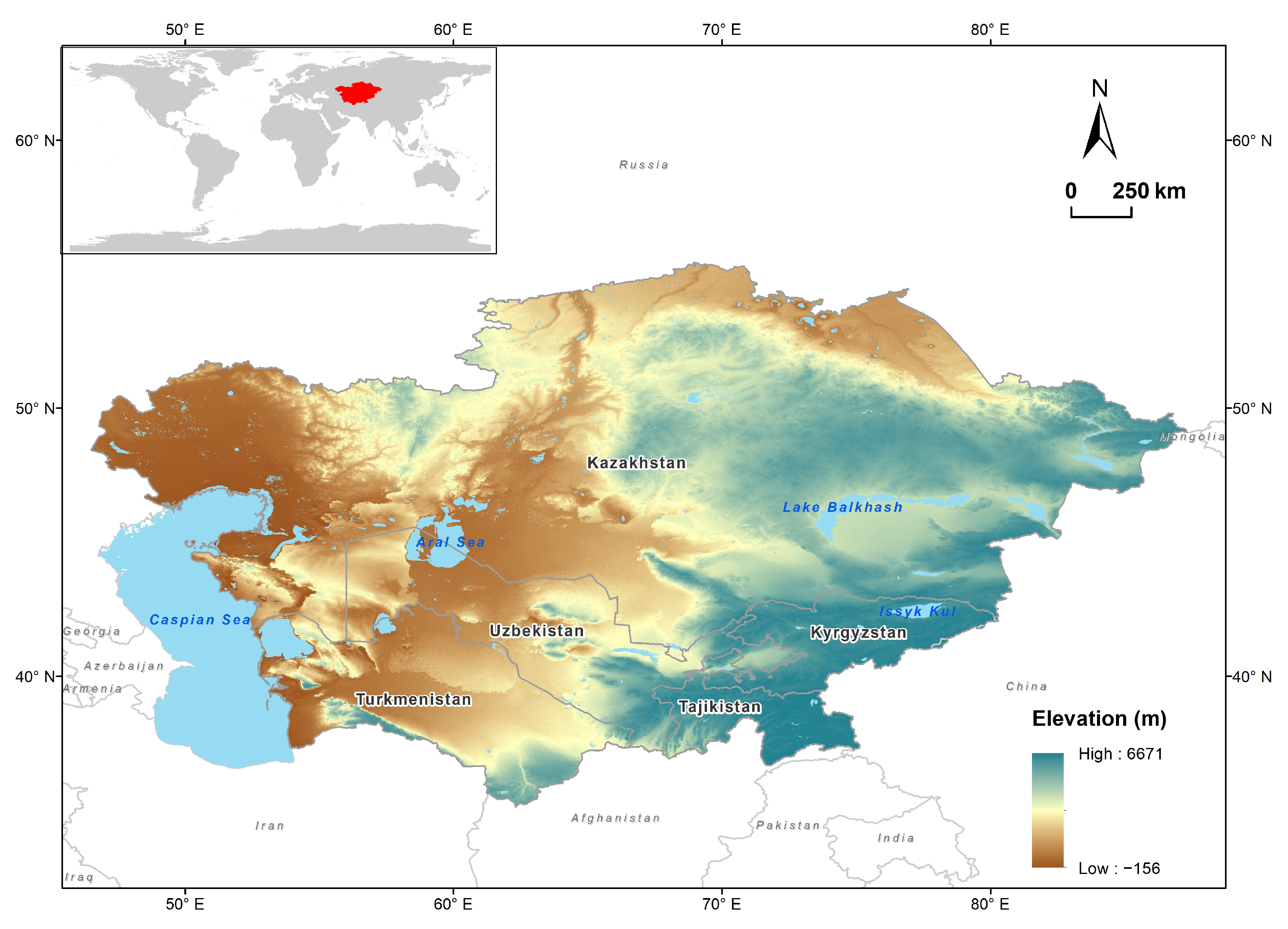
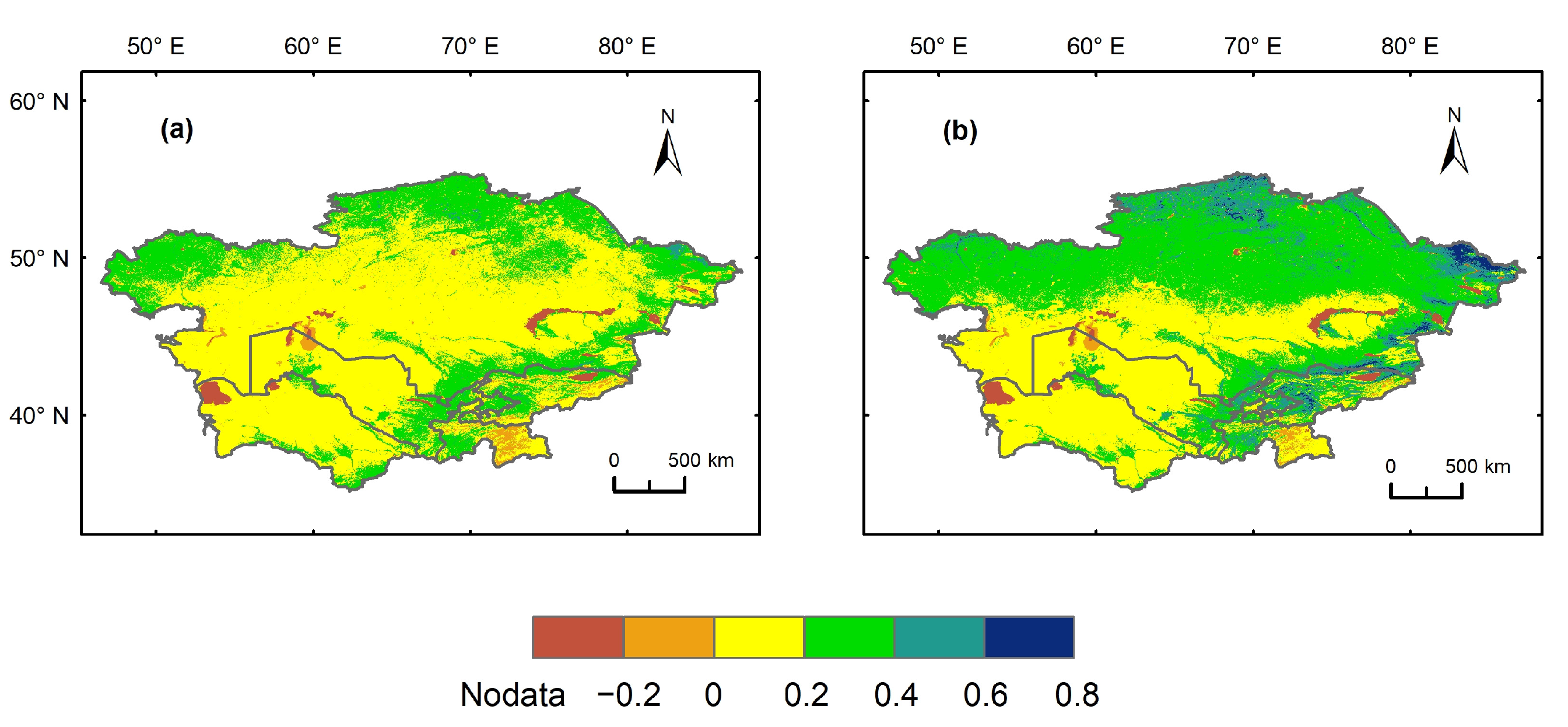


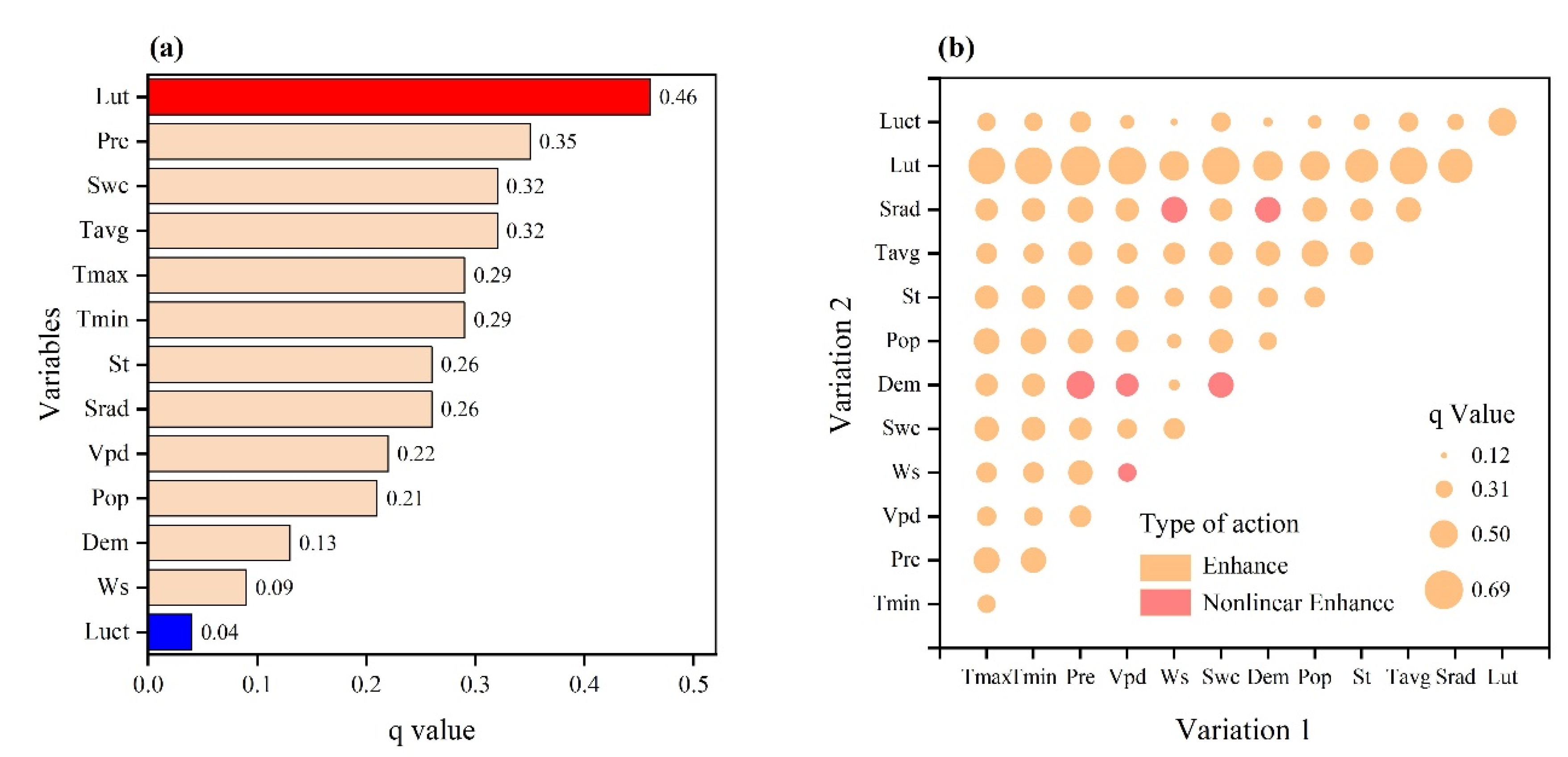
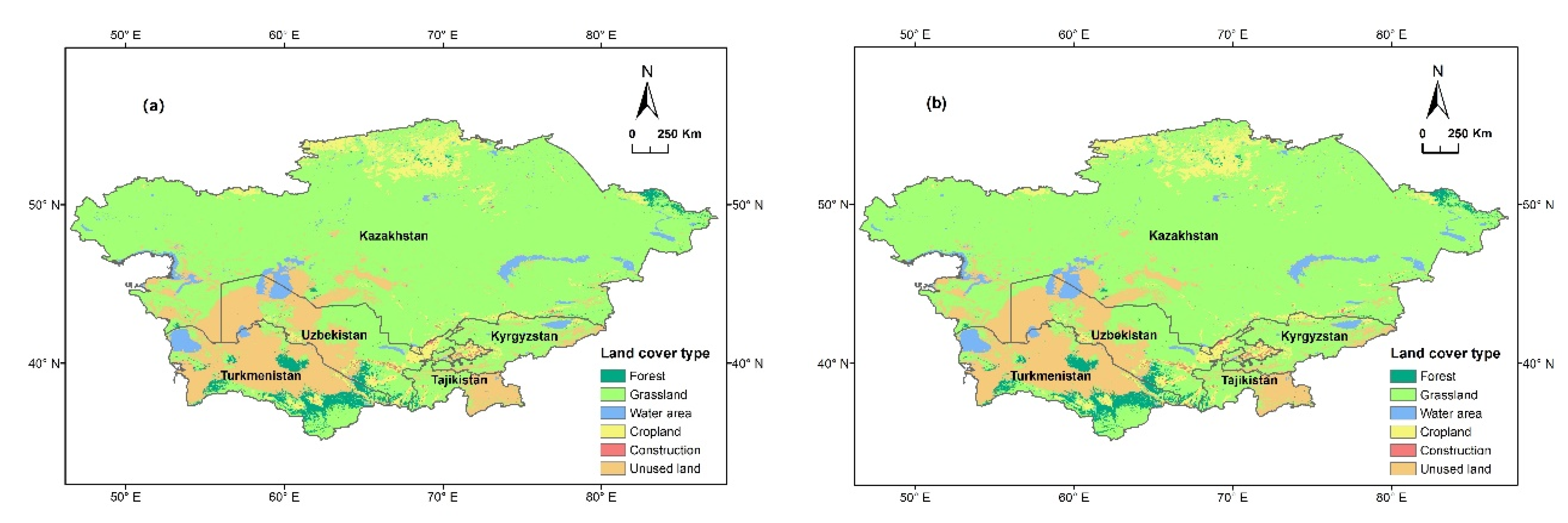
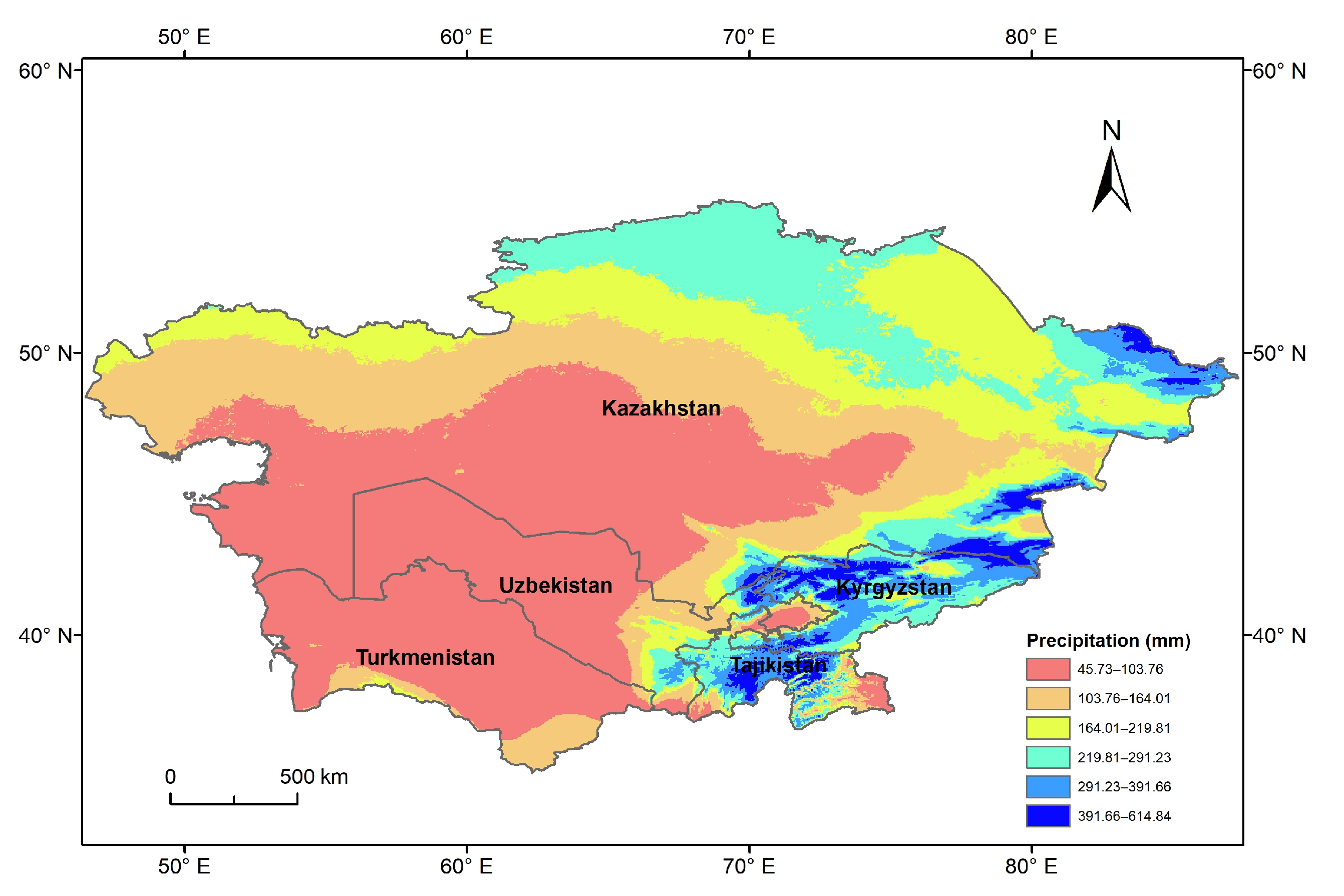
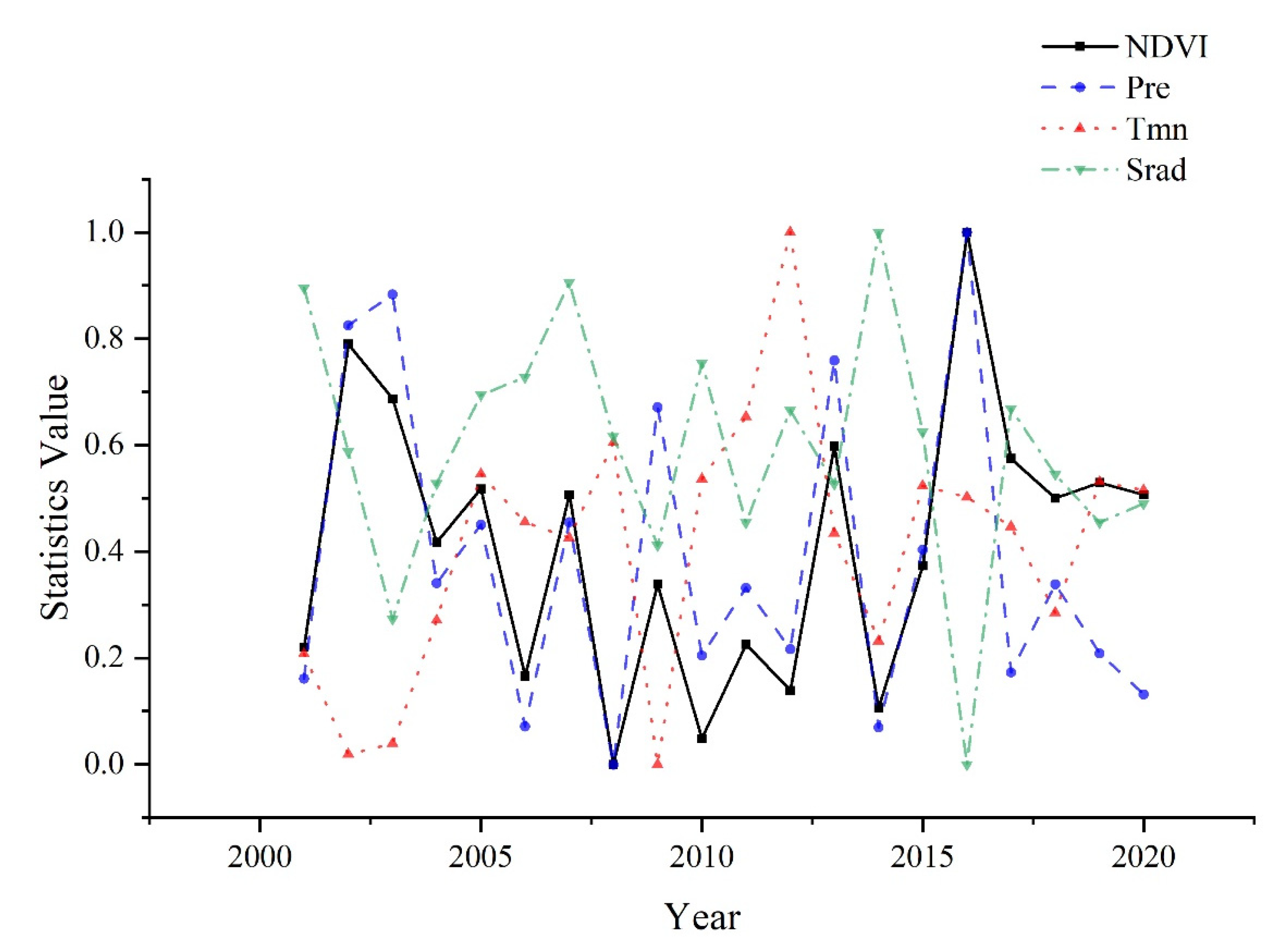

| Respects | Variables | Abbreviation | Datasets | Time Period | Resolution |
|---|---|---|---|---|---|
| Vegetation | NDVI | NDVI | MODIS13Q1 | 2001–2020 | 250 m |
| Climate | Wind speed | Ws | TerraClimate | 2001–2020 | 1/24° |
| Vapor pressure deficit | Vpd | ||||
| Precipitation | Pre | ||||
| Soil water content | Swc | ||||
| Maximum temperature | Tmax | ||||
| Minimum temperature | Tmin | ||||
| Average temperature | Tavg | CRU | 0.5° | ||
| Surface shortwave radiation | Srad | MERRA-2 | 0.5° | ||
| Geographic | Soil type | St | HWSD | 2012 | 1 km |
| Land-use type | Lut | MCD12Q1 | 2001, 2020 | 500 m | |
| Anthropogenic | Land-use conversion type | Luct | MCD12Q1 | / | 500 m |
| Population | Pop | LandScan | 2001–2020 | 1 km |
| Value Comparisons | Types of Interaction |
|---|---|
| Non-linear weakened | |
| Weakened | |
| Enhanced | |
| Independent | |
| Non-linear enhanced |
| 2001–2020 | 2001–2010 | 2011–2020 | |||
|---|---|---|---|---|---|
| Variable | Variable | Variable | |||
| Pre | 0.78 ** | Pre | 0.89 ** | Vpd | −0.82 ** |
| Swc | 0.72 ** | Vpd | −0.86 ** | Srad | −0.81 ** |
| Vpd | −0.67 ** | Swc | 0.79 ** | Swc | 0.74 * |
| Srad | −0.62 ** | Tmax | −0.74 * | Pre | 0.73 * |
| Tmax | −0.38 | Tmin | −0.62 | Tmin | 0.39 |
| Tavg | −0.32 | Tavg | −0.62 | Tavg | −0.25 |
| Ws | −0.32 | Ws | −0.56 | Ws | −0.18 |
| Tmin | −0.11 | Srad | −0.37 | Tmax | 0.1 |
Disclaimer/Publisher’s Note: The statements, opinions and data contained in all publications are solely those of the individual author(s) and contributor(s) and not of MDPI and/or the editor(s). MDPI and/or the editor(s) disclaim responsibility for any injury to people or property resulting from any ideas, methods, instructions or products referred to in the content. |
© 2023 by the authors. Licensee MDPI, Basel, Switzerland. This article is an open access article distributed under the terms and conditions of the Creative Commons Attribution (CC BY) license (https://creativecommons.org/licenses/by/4.0/).
Share and Cite
Gao, C.; Ren, X.; Fan, L.; He, H.; Zhang, L.; Zhang, X.; Li, Y.; Zeng, N.; Chen, X. Assessing the Vegetation Dynamics and Its Influencing Factors in Central Asia from 2001 to 2020. Remote Sens. 2023, 15, 4670. https://doi.org/10.3390/rs15194670
Gao C, Ren X, Fan L, He H, Zhang L, Zhang X, Li Y, Zeng N, Chen X. Assessing the Vegetation Dynamics and Its Influencing Factors in Central Asia from 2001 to 2020. Remote Sensing. 2023; 15(19):4670. https://doi.org/10.3390/rs15194670
Chicago/Turabian StyleGao, Chao, Xiaoli Ren, Lianlian Fan, Honglin He, Li Zhang, Xinyu Zhang, Yun Li, Na Zeng, and Xiuzhi Chen. 2023. "Assessing the Vegetation Dynamics and Its Influencing Factors in Central Asia from 2001 to 2020" Remote Sensing 15, no. 19: 4670. https://doi.org/10.3390/rs15194670
APA StyleGao, C., Ren, X., Fan, L., He, H., Zhang, L., Zhang, X., Li, Y., Zeng, N., & Chen, X. (2023). Assessing the Vegetation Dynamics and Its Influencing Factors in Central Asia from 2001 to 2020. Remote Sensing, 15(19), 4670. https://doi.org/10.3390/rs15194670








